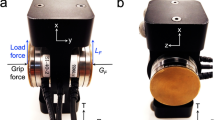Abstract
The dynamic response of a vibrating handarm system is strongly related to the grip force. While the relationship between total grip force and vibration characteristics of the hand-arm system has been extensively studied, no attempts have been made to investigate the distribution of grip pressure at the hand-handle interface. The local grip-pressure distribution may be more closely related to the finger blood flow, fatigue and loss of productivity than total grip force. In the present study, distribution of static and dynamic forces at a hand-handle interface is investigated using a grid of pressure sensors mounted on the handle. The pressure distribution is acquired for different values of static and dynamic grip forces in the range of 25–150 N. The dynamic measurements were conducted at various discrete frequencies in the 20–1000 Hz range with peak acceleration levels of 0.5 g, 1.0 g, 2.0 g and 3.0 g. The grip-pressure distribution under static loads revealed a concentration of high pressures near the tips of the index and middle fingers, and the base of the thumb. This concentration of high pressures shifted towards the middle of the fingers under dynamic loads, irrespective of grip force, excitation frequency and acceleration levels. These local pressure peaks may be related to impairment of blood flow to finger tips and the possible causation of vibration white finger.
Similar content being viewed by others
References
Wassermann, D.E., Human Aspects of Occupational Vibration, Elsevier Science Pub., 7–34 (1987).
Brammer, A.J., Relations Between Vibration Exposure and the Development of the Vibration Syndrome, ed. Brammer, andTaylor, Vibration Effects on the Hand and Arm in Industry, John Wiley & Sons, New York, 283–290 (1982).
Gruber, G.J., “Relationship Between Whole-body Vibration and Morbidity Patterns among Interstate Truck Drivers,” NIOSH Publication No. 77-167 (1976).
Wasserman, D.E., Reynolds, D.D., Behrens, V., Samueloff, S. and Basel, R., “Vibration White Finger Disease in U.S. Workers Using Pneumatic Chipping and Grinding Hand-Tools,” Vol. II, Engineering Testing, NIOSH Publication No. 82-101 (1982).
Pyykkö, I., Färkkilä, M., Toivanen, J., Korhonen, O. andHyvärinen, J., “Transmission of Vibration in the Hand-Arm System with Special Reference to Changes in Compression Force and Acceleration,”Scandinavian J. Work, Environment and Health,2,87–95 (1976).
Rasmussen, G., “Human Body Vibration Exposure and Its Measurements,” Bruel and Kjaer Tech. Rev. No. 1, (1982).
Fellows, G.L. and Frievalds, A., “Ergonomics Evaluation of a Foam Rubber Grip for Tool Handles,” Appl. Ergonomics, 225–230 (1991).
Linden, O., Greenway, R.M. and Piazza, J.M., “Pressure Distribution on the Surface of the Human Body: I. Evaluation in Lying and Sitting Positions Using a Bed of Springs and Nails,” Arch. of Phys. Med. & Rehab., 378–385 (1965).
Holly, L.K., “A New Pressure Measuring System for Cushions and Beds with a Review of the Literature,”Paraplegia,17,461–474 (1979).
Abrams, C.F., “Modeling the Vibrational Characteristics of the Human Hand by Driving Point Mechanical Impedance Method,” North Carolina State Univ. Raleigh, PhD Thesis (unpublished), 28–29 (1971).
Krause, P., Orban A., Panzke, K.J. and Popov, K., “Critical Assessment of Common Methods to Determine Vibrational Stress of Hand-arm System,” Int. Symp. Man Under Vibration Suffering and Protection, Udine (Italy), 261–274 (1979).
Piché, A., Rakheja, S., Gouw, G.J. and Sankar, T.S., “Development of an Elastic Human-seat Interface Pressure Sensing System,” ICAART 88, Montreal, 118–119 (1988).
Seitz, P., Personal communications on MICROEMED system developed by NOVEL gmbh, Germany, (1990).
Mishoe, J.W. andSuggs, C.W., “Hand-arm Vibration. Part II: Vibrational Responses of the Human Hand,”J. Sound and Vib.,53,545–558 (1974).
Wood, L.A., Suggs, C.W. andAbrams, C.F., “Hand-arm Vibration Part III: A Distributed Parameter Dynamic Model of the Human Handarm System,”J. Sound and Vib.,57,157–169 (1978).
Brubaker, R.L., Mackenzie, C.J.G. andBates, D.V., “Vibration White Finger Disease Among Tree Fellers in British Columbia,”J. Occupational Medicine,25,403–408 (1983).
Hellström, B. andAndersen, K.L., “Vibration Injuries in Norwegian Forest Workers,”Brit. J. Ind. Medicine,29,255–263 (1972).
Author information
Authors and Affiliations
Rights and permissions
About this article
Cite this article
Gurram, R., Gouw, G.J. & Rakheja, S. Grip pressure distribution under static and dynamic loading. Experimental Mechanics 33, 169–173 (1993). https://doi.org/10.1007/BF02322568
Received:
Revised:
Issue Date:
DOI: https://doi.org/10.1007/BF02322568




